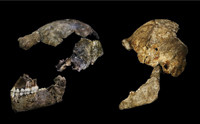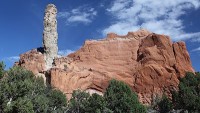By Troy Lacey Evidence of such large-scale catastrophes are yet another reminder that the present is not the key to the past. …read more Read more here: AIG Daily
By Dr. Andrew A. Snelling Terrestrial vertebrates close to the Flood fountains dissolved then precipitated out to form Precambrian-Cambrian sedimentary phosphate deposits. …read more Read more here: AIG Daily
By Dr. John Whitmore The Flood is impossible because one of the Grand Canyon’s layers was deposited in a desert. Or so evolutionists claim. Do the facts back them up? …read more Read more here: AIG Daily
A New Scientist article1 ponders a baffling enigma to evolutionists—‘living fossils’. These are creatures alive today which are identical to fossilised forms, believed to have lived ‘millions of years ago.’ Examples include the coelacanth fish (fossil coelacanths are believed by evolutionists to be 340 million years old2), Gingko trees (125 million years), crocodiles (140 million years), horseshoe crabs (200 million years), the Lingula lamp shell (450 million years), Neopilina molluscs (500 million years), and the tuatara lizard (200 million years). This poses a conundrum for evolution: ‘Why have these life-forms stayed the same for all that time?’This poses a conundrum [More]
Our first article on Homo naledi addressed questions about the anatomy and geologic setting of these fossils. Our second asked why these scientists chose to not date the fossils. This third and final article explores the question of how the fossils arrived in such a remote part of the cave. This may be the toughest of the three questions to answer. More… …read more Read more here: icr.org
‘If Noahs Flood really happened, then why don’t we see any evidence for it?’ a skeptic might ask. In today’s era of mass-media disinformation, this type of question is hurled at Bible-believers daily. The answer is quite simply this: evidence for Noah’s Flood is everywhere, but it is not reported as such by mainstream secular sources. A recent Associated Press article posted on the Guardian website provides us yet another perfect example of how evidence can be hidden in plain sight and presented in a completely dishonest way. Read More: Unpermineralized hadrosaur bones Alaska – creation.com
By Dr. Andrew A. Snelling The biblical worldview changes how you see everything, even a “paradise” like Hawaii. …read more Read more here: AIG Daily
When describing so-called ‘transitional’ fossils, we often call such fossils ‘mosaic fossils’. What do we mean? Read More: Mosaic fossils – creation.com
In the first of our three articles on this news-grabbing subject, we pointed out some strange circumstances surrounding the geology of the cave systems in which Homo naledi was discovered, as well as critical mismatches in bony body parts. This second article exposes a strange lack of evolutionary dating methods. Why has lead researcher Lee Berger, who is touring the world touting these fossils, not performed even one of several standard dating methods for fossils? More… …read more Read more here: icr.org
Recent claims of a transitional species named Homo naledi have the anthropologic world in an uproar. The new fossil “species” is said to be a human-like ancestor that neatly fills the gap between the Australopithecus and our own genus Homo. This seemingly fits the human evolution story promulgated since the 19th century, but what are these bones really? More… …read more Read more here: icr.org
How do we explain ‘apeman’ fossils from a biblical perspective? …read more Read more here: creation.com
By Frost Smith Scientists were hoping for insight into why so many fossilized dinosaurs are buried in rock appearing to be in what’s been called the “throes of death” posture. …read more Read more here: AIG Daily
The Lake Missoula flood can’t be tamed by spreading it over long periods of time. …read more Read more here: creation.com
‘Mud cracks’, as they are commonly called, form when muddy sediment is exposed to the air and dries out. This causes the mud to dehydrate, shrink and crack. Some Bible critics claim that mud cracks disprove the global flood, because they are supposedly found throughout the geological record, and therefore imply a series of prolonged periods of drying out, instead of one great watery cataclysm that laid down most sedimentary layers. However, this argument is far from ‘rock solid’, because true mud cracks are easy to confuse with cracks formed by other mechanisms that don’t involve a period of drying [More]
By Bill Hoesch Secluded in the canyon country of southern Utah is a beautiful but often overlooked state park called Kodachrome Basin. …read more Read more here: AIG Daily
Questionable assumptions about how volcanic andesite lava is produced suggests caution before accepting uniformitarian interpretations. …read more Read more here: creation.com
Fossil leaves show that leaf miners have existed along with leaves and questions the long ages attributed to these fossils. …read more Read more here: creation.com
Homo naledi is another case of selective interpretation of the evidence to ‘prove’ evolution of man from apelike ancestors. …read more Read more here: creation.com
Explained by biblical history. …read more Read more here: creation.com
By Ken Ham Do you realize that Homo means different things to different scientists? When an evolutionist classifies a fossil as Homo, he does not mean the same thing a Bible-believing scientist does. There has already been a lot of buzz on evolutionists’ websites and blogs mocking our assessment that the published evidence does not support a Homo designation for Homo naledi. Ignoring how much evolutionary scientists disagree among themselves, some make much of disagreement among creationists about Homo naledi‘s identity. One in particular, in “Bones of Contention: How Will Creationists Respond To A Huge New Hominid Fossil Find?,”predicted responses [More]
Spring rains flooded the Dallas area this year, including Lake Grapevine which is about 10 miles west of the Institute for Creation Research (ICR) campus. Record water levels submerged entire lakeside parks and adjacent roads. As the water slowly receded, it revealed a reshaped shoreline—and dinosaur tracks. What kinds of creatures made these marks? More… …read more Read more here: icr.org
By Ken Ham The media is buzzing with news that another supposed human ancestor has been found in an African cave. It was discovered by evolutionist Lee Berger, whose controversial claims about Australopithecus sediba have been in the news off and on since 2011. (You can read them in “Sediba with a Little Sleight of Hand,” “Sediba Fossils Fail to Connect the Evolutionary Dots,” “Karabo: The Smiling Missing Link,” and “Can Karabo Catch Up with Lucy’s Legacy?”) Dr. Elizabeth Mitchell, who frequently writes articles for Answers in Genesis, is working on a full-length article on this discovery, so keep checking [More]
Richard Dawkins says a rabbit fossil in the Precambrian would be evidence against evolution, but would that really be the case? …read more Read more here: creation.com
Skeptics ask where are all the human fossils if there were really a global Flood? Are there answers? …read more Read more here: creation.com
By Dr. Andrew A. Snelling The visitor overlooks at Bryce Canyon, Utah, provide a breathtaking spectacle of row upon row of towering columns. …read more Read more here: AIG Daily
But Flood geology explains them. …read more Read more here: creation.com
By Dr. Andrew A. Snelling The Giant’s Causeway is Northern Ireland’s most iconic landmark. …read more Read more here: AIG Daily









































